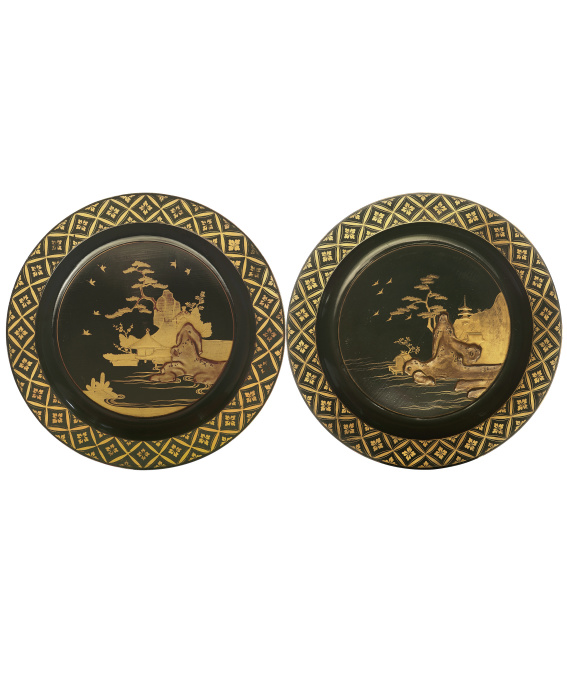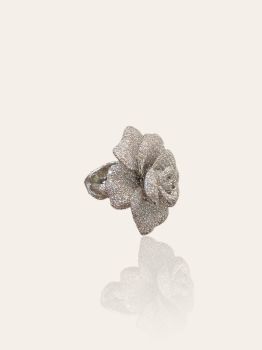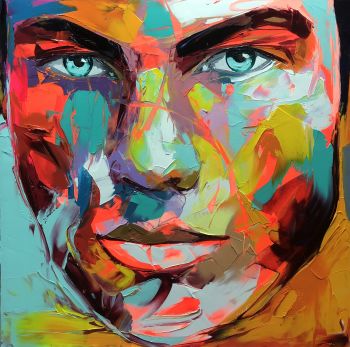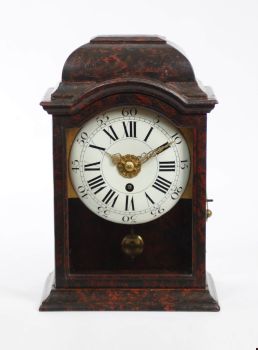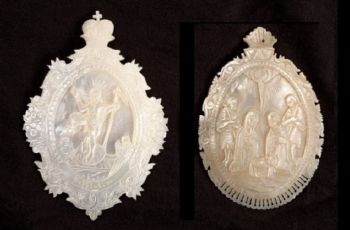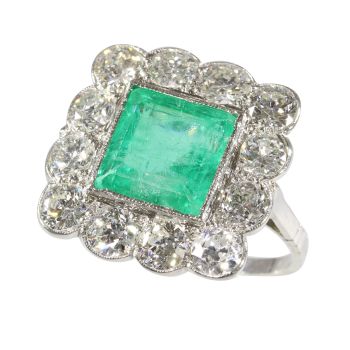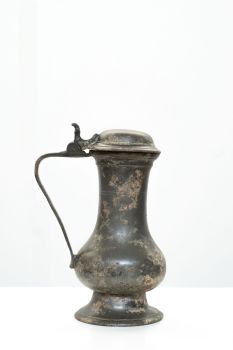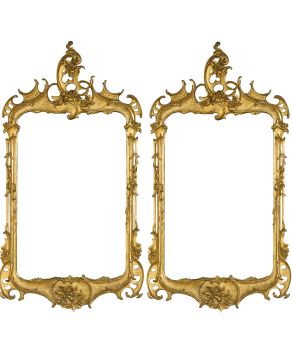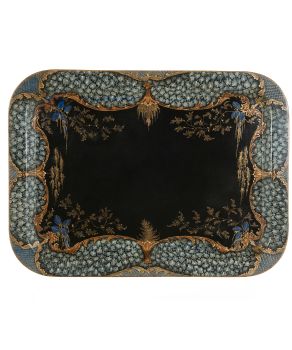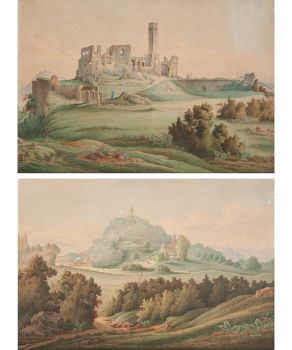A Pair Japanese Export Black Lacquered Wood Plates - Edo period 1700
Unknown artist
ø 30 cm
ConditionMinor damages
€ 6.000
Van Nie Antiquairs
- About the artworkA pair of light circular plates of lacquered wood (urushi), modeled with swallow, flaring and rounded sides and a flat rim with engrossed edge. Decorated in pictorial style with gold lacquer (maki-e). The centre decorated in flat and low relief (tahamaki-e) with imaginary landscape scenes with trees, rockwork and water. The flat rim is decorated with a typical border of endless pearl (shippôtsungi) in gold lacquer. Standing on a short foot-ring. These plates were made to be exported to Europe at the end of the 17th and early 18th Century.
Other similar plates are in:
The Collection of Her Majesty the Queen, London
The Collection of the Groningen Museum (inv.no. 1978.447)
Peabody Essex Museum in Salem
Palazzo Pitti, Florence., and others
Literature:
Jorge Welsh/L.Vinais After the Barbarians. Namban Works of Art for the Japanese, Portuguese and Dutch Market. Lisbon, 2008. p.334. no. 47
O.Impey / C.Jörg. Japanese Export Lacquer. 1580-1850. p.117. no.420. - About the artist
It might happen that an artist or maker is unknown.
Some works are not to be determined by whom it is made or it is made by (a group of) craftsmen. Examples are statues from the Ancient Time, furniture, mirroirs, or signatures that are not clear or readible but as well some works are not signed at all.
As well you can find the following description:
•“Attributed to ….” In their opinion probably a work by the artist, at least in part
•“Studio of ….” or “Workshop of” In their opinion a work executed in the studio or workshop of the artist, possibly under his supervision
•“Circle of ….” In their opinion a work of the period of the artist showing his influence, closely associated with the artist but not necessarily his pupil
•“Style of ….” or “Follower of ….” In their opinion a work executed in the artist’s style but not necessarily by a pupil; may be contemporary or nearly contemporary
•“Manner of ….” In their opinion a work in the style of the artist but of a later date
•“After ….” In their opinion a copy (of any date) of a work of the artist
•“Signed…”, “Dated….” or “Inscribed” In their opinion the work has been signed/dated/inscribed by the artist. The addition of a question mark indicates an element of doubt
•"With signature ….”, “With date ….”, “With inscription….” or “Bears signature/date/inscription” in their opinion the signature/ date/ inscription has been added by someone other than the artist
Are you interested in buying this artwork?
Artwork details
Related artworks
- 1 - 4 / 12
Unknown artist
A IVORY NETSUKE OF A DUTCHMAN HOLDING A COCKEREL18th century
Price on requestZebregs & Röell - Fine Art - Antiques
Unknown artist
A MARINE IVORY NETSUKE OF A DUTCHMAN HOLDING A CHINESE FAN18th century
Price on requestZebregs & Röell - Fine Art - Antiques
Unknown artist
The Stamford Raffles Secretaires.1800 - 1813
Price on requestZebregs & Röell - Fine Art - Antiques
Unknown artist
AN IVORY NETSUKE OF A DUTCHMAN FROLICKING WITH A SMALL BOY18th century
Price on requestZebregs & Röell - Fine Art - Antiques
Unknown artist
A RARE LARGE JAPANESE LACQUERED LEATHER TELESCOPE1750 - 1800
Price on requestZebregs & Röell - Fine Art - Antiques
Unknown artist
A JAPANESE SMALL SAWASA 'PEACH-FORM' CRUCIBLE CUPearly 18th
Price on requestZebregs & Röell - Fine Art - Antiques
Unknown artist
A SMALL IVORY NETSUKE OF A DUTCHMAN WITH A DRUM1750 - 1800
Price on requestZebregs & Röell - Fine Art - Antiques
Unknown artist
A rare Japanese export lacquer medical instrument box1650 - 1700
Price on requestZebregs & Röell - Fine Art - Antiques
1 - 4 / 21- 1 - 4 / 4

